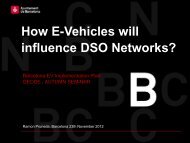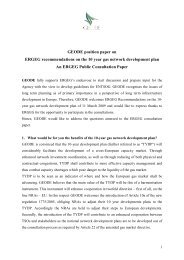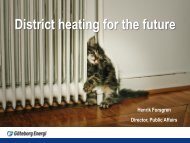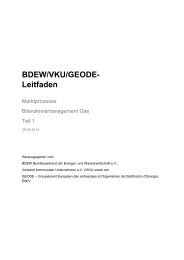Gas Networks as Electricity Storage Dr. Christian Urbanke - Geode
Gas Networks as Electricity Storage Dr. Christian Urbanke - Geode
Gas Networks as Electricity Storage Dr. Christian Urbanke - Geode
- No tags were found...
Create successful ePaper yourself
Turn your PDF publications into a flip-book with our unique Google optimized e-Paper software.
<strong>G<strong>as</strong></strong> <strong>Networks</strong> <strong>as</strong> <strong>Electricity</strong> <strong>Storage</strong><strong>Dr</strong>. <strong>Christian</strong> <strong>Urbanke</strong>Corporate TechnologyElectronics, Energy & EnvironmentGEODE Spring SeminarBrussels, 3 rd May 2012© Siemens AG 2011
Trends in power generation -Two possible scenariosPower Generation (in 1000 TWh¹)21.04%15%13%21%5%42%+2.8% p.a.CAGR+9.6 %68%58%WindOnshore36.713%15%14%21%3%34%OceanBiom<strong>as</strong>s, W<strong>as</strong>te1%17% Geothermal40% 4%6% Solar CSP11%WindOffshore21%Solar PV13–17%34–30%35.717%15%14%22%3%30%RenewablesHydroNuclear<strong>G<strong>as</strong></strong>OilCoalWorld power generation(in 1000 TWh)Bright Green Scenario<strong>as</strong>sumptions:• Cost-cuts in renewables• Energy storage available• Expansion of transmissiongrids• <strong>G<strong>as</strong></strong> to compensate forintermittency of renewablesSource: Siemens20102030B<strong>as</strong>e C<strong>as</strong>ePage 2 April 2012 <strong>Dr</strong>. <strong>Christian</strong> <strong>Urbanke</strong>2030Bright Green Scenario© Siemens AG 2011© Siemens AG, Corporate Technology
Today’s renewable power generation in GermanyMW25.00020.000Renewable power generation in Germany during 11.-24.03.2012Wind (MW)PV (MW)Sum (MW)66 % of25 GW !!15.00010.0005.000011.03.2012-0012.03.2012-0013.03.2012-0021.03.2012-0020.03.2012-0019.03.2012-0018.03.2012-0017.03.2012-0016.03.2012-0015.03.2012-0014.03.2012-0022.03.2012-0023.03.2012-0024.03.2012-00Source: Data from EEX Transparency Platform, actual production, March 2012Page 3 April 2012 <strong>Dr</strong>. <strong>Christian</strong> <strong>Urbanke</strong>© Siemens AG, Corporate Technology
Installations of wind power continue to growMW3500030000Installed wind power in GermanyWorld installed wind power in 201025000200001500010000500002000 2001 2002 2003 2004 2005 2006 2007 2008 2009 2010 2011 2012Source: FhG IWESTWh/aWind power generation in GermanyN-America22,4%Pacific region1,2%(2.4 GW)44.2 GWLatin America1,0%61.1 GW(2.0 GW)Africa/ ME0,5%86.3 GW(1.08 GW)Europe43,8%6050Real energy harvestPotential energy harvestAsia31,0%4030201002000 2001 2002 2003 2004 2005 2006 2007 2008 2009 2010 2011Source: Bundesverband WindEnergie (BWE)Page 4 April 2012 <strong>Dr</strong>. <strong>Christian</strong> <strong>Urbanke</strong>© Siemens AG 2011
Gross power generation (GW)Gross power generation will strongly incre<strong>as</strong>edue to renewable energies85 %65 GW PV40 GW Wind offshore40 GW Wind onshoreSource: BMU Leitstudie 2010, Hannover Energieversorgung der Zukunft, Power Plant Technol. Forum 2011Page 5 April 2012 <strong>Dr</strong>. <strong>Christian</strong> <strong>Urbanke</strong>© Siemens AG, Corporate Technology
What is the energy storage neededfor a 85% RE scenario in Germany?Today‘s pumped hydro capacity:0.04 TWhPV: 65 GWWind on : 40 GWWind off : 40 GWIn c<strong>as</strong>e of 85% renewable energy supply, transport and storage will be the main issues.For a reliable power supply the energy demand of 20 days defines the required capacity of 30 TWh.Sources: FhG IWES (2010); DLR; Nitsch, Sterner, et al. 2010 (BMU Leitszenarien Zwischenbericht)Page 6 April 2012 <strong>Dr</strong>. <strong>Christian</strong> <strong>Urbanke</strong>© Siemens AG, Corporate Technology
Urge for more electricity and incre<strong>as</strong>ing fluctuation ofpower flow in the electrical gridGrowing demandHigh share of renewablesStoch<strong>as</strong>tic power flowIncre<strong>as</strong>ingly distributed generationPage 7 April 2012 <strong>Dr</strong>. <strong>Christian</strong> <strong>Urbanke</strong>© Siemens AG, Corporate Technology
Integration of renewable energy sources in 2020 -effects on the transmission gridScenarios:(1) B<strong>as</strong>ic grid with standard transmissioncapacity, without additional storage(2) New HV routes with Flexible LineManagement (FLM)(3) High-temperature conductors (TAL)ScenarioNeed for constructionof additional routesRoute lengthto be modifiedCosts(1) 3600 km 0 km € 0.946 bill. pa(2) 3500 km 3100 km € 0.985 bill. pa(3) 1700 km 5700 km € 1.617 bill. paTransmission technologies:• Conv. 380 kV AC overhead lines• 800 kV AC overhead lines• Underground 380 kV cables• HVDC transmission b<strong>as</strong>ed onoverhead lines• Underground HVDC cables• <strong>G<strong>as</strong></strong>-insulated lines (GIL)Source: dena Grid Study II (2011)Page 8 April 2012 <strong>Dr</strong>. <strong>Christian</strong> <strong>Urbanke</strong>VSC-HGÜ = Voltage Source Converter HVDC© Siemens AG, Corporate Technology
Our customer's world is in transformation – From“generation follows load” to “load follows generation”BEFOREResidentialLargeCommercialAFTERWARDSIndustrialLightCommerciallong distance transmissionBi-directionalcurrent flowHVDC HubBiom<strong>as</strong>s~hydro powerGeothermalSmart Grid is the answer to the changing requirementsPage 9April 2012<strong>Dr</strong>. <strong>Christian</strong> <strong>Urbanke</strong>© Siemens AG 2011. All rights reserved
Energy storage technologiesavailable in GermanyPumped hydroNatural g<strong>as</strong> cavern<strong>G<strong>as</strong></strong> vesselCAES storage facility<strong>G<strong>as</strong></strong> gridFoto: RWEPage 10 April 2012 <strong>Dr</strong>. <strong>Christian</strong> <strong>Urbanke</strong>© Siemens AG, Corporate Technology
Energy <strong>Storage</strong> TechnologiesEnergy density of storage medium• The pumped hydro storagetechnology h<strong>as</strong> a very low energydensity• The energy density of CAES is4 times higher• Hydrogen appears technically <strong>as</strong> themost promising storage medium• Cost and economic <strong>as</strong>pects of H 2production have a strong impact onthe development of industrial-scalestorage facilitiesKey components for an economic hydrogen storage are electrolyzers with► low-cost,► high-efficiency and► long-lifetimeSource: Deutsche Energie-AgenturPage 11 April 2012 <strong>Dr</strong>. <strong>Christian</strong> <strong>Urbanke</strong>© Siemens AG 2011
Power [MW]0,001 0,01 0,1 1 10 100 1.000 10 4Large Scale Energy <strong>Storage</strong>Options to address ‘grid storage’ are limitedsegmentation of large-scale (electrical) energy storageelectricvehicles1 secsinglewind turbinewindpark1 min1 h1 d1 d1 mKey statements:• Battery storage applicationsare limited in the hour range• Energy storage >100 MWcan only be addressed bypumped hydro, compressedair (CAES) and hydrogenSuperCapsall data averaged• The potential to extendpumped hydro capacities isvery limited• CAES h<strong>as</strong> limitations inoperational flexibility andcapacity0,001 0,01 0,1 1 10 100 1.000 10 4 10 5Energy [MWh]Hydrogen is the only viable option for energy capacities >10 GWhPage 12 April 2012 <strong>Dr</strong>. <strong>Christian</strong> <strong>Urbanke</strong>© Siemens AG 2011
What is the energy storage neededfor a 85% RE scenario in Germany?In c<strong>as</strong>e of 85% renewable energy supply, we need an energy storage capacity of 30 TWh.To store the energy of 30 TWh we need of the existing• Pumped hydro capacity750 times• Cavern capacity used for CNG 0.15 times (15%)• CNG grid capacity (>6 MPa) 0.70 times (70%)Taking hydrogen into consideration for 30 TWh we need a storage capacity of4.9 bill. m³, which is approx. 25% of the existing NG cavern capacitya strong motivation for using hydrogen <strong>as</strong> energy carrierSources: dena Grid Study II (2011); FhG IWES (2010); DLR; Nitsch, Sterner, et al. 2010 (BMU Leitszenarien Zwischenbericht)Page 13 April 2012 <strong>Dr</strong>. <strong>Christian</strong> <strong>Urbanke</strong>© Siemens AG, Corporate Technology
Hydrogen <strong>as</strong> storable energy carrier –Green production from excess renewable energyGeneration Conversion <strong>Storage</strong>ApplicationO 21. Industrial use (semiconductor,metals, float gl<strong>as</strong>s, foodhydrogenation)H 2up to 100 MWh*> 100 GWh**2. Re-electrification via g<strong>as</strong> turbine(saving of CH 4 )3. Heating for households andindustry (additive to CH 4 )4. Fuel for vehicles (combustionengines or fuel cells)* on the b<strong>as</strong>is of 50 bar** on the b<strong>as</strong>is of 50 bar; more than 300 bar demonstrated5. Synthesis of bio-fuels andchemical raw materials via CO 2fixation (e.g. MeOH, CH 4 , ...)Hydrogen is a multi-functional and e<strong>as</strong>ily storable energy carrierPage 14 April 2012 <strong>Dr</strong>. <strong>Christian</strong> <strong>Urbanke</strong>© Siemens AG, Corporate Technology
German g<strong>as</strong> and power gridNatural g<strong>as</strong> storage facilityNatural g<strong>as</strong> transportation grid >60 barPower grid 220 kVPower grid 380 kVThe g<strong>as</strong> grid in Germany is growingLength of the g<strong>as</strong> grid in Germany (in km)Source: DVGW Innovation initiative (2011)Page 15 April 2012 <strong>Dr</strong>. <strong>Christian</strong> <strong>Urbanke</strong>© Siemens AG, Corporate Technology
cell voltage [ V ]PEM Electrolyzers @ SiemensPressure operationPerformance characteristic of a Siemens PEM electrolyzer stack(lab demonstrator)32,521,5100 bar50 bar1 barKey statements:Pressurized operation is preferablebecause:• compressors causes additionalinvest and efficiency losses• H 2 compression in particular ismaintenance intensive10 1 2 3 4typical range of current density [ A/cm² ]alkaline electrolyzers• compression requires less effortswhen starting at medium pressurelevelsPEM electrolyzers can be operated with high pressure. In real operation, thereis no relevant efficiency loss compared to the ambient pressure mode.Page 16 April 2012 <strong>Dr</strong>. <strong>Christian</strong> <strong>Urbanke</strong>© Siemens AG 2011
Principle of Polymer Electrolyte MembraneElectrolysis (PEM)electrodesPolymer-Electrolyte-MembraneFunctionalities:‣ ion conductivity‣ electric insulation‣ g<strong>as</strong> separationg<strong>as</strong> diffusion layerbipolar plate withg<strong>as</strong> channelsPage 17 April 2012 <strong>Dr</strong>. <strong>Christian</strong> <strong>Urbanke</strong>© Siemens AG, Corporate Technology
PEM Electrolyzers @ SiemensOperation <strong>as</strong> control power• startup time (blackstart) ~ 10 min• from standby to full load in < 10 sec• full dynamic behavior between 0 and 300% electric load (positive, negative or combined mode control power)Power in %normal operationprovidingnegative control powerprovidingpositive control power300%13 kg H 2 /MWnegative control load:200 %200%15 kg H 2 /MW100%18 kg H 2 /MWpositive control load:100 kWPEM electrolyzers can be operated <strong>as</strong> efficient dynamic load for secondary andeven primary control powerPage 18 April 2012 <strong>Dr</strong>. <strong>Christian</strong> <strong>Urbanke</strong>© Siemens AG 2011
Lighthouse Project ElectrolyzerDemonstratorsDesign autarkicsystemContainer System (FY 11/12)Incre<strong>as</strong>e numberof cells2 Stack System (FY 10/11)Small Stack (FY 09/10)Incre<strong>as</strong>ingcell sizeHandlingseveral stacksEnvironment: Autarkic Container(Outdoor)Environment: LaboratoryEnvironment:LaboratoryExperience in design, development, <strong>as</strong>sembly and evaluation of lab-scale demonstratorsresult in the know how to go for the 100 kW autarkic container b<strong>as</strong>ed systemPage 19 April 2012 <strong>Dr</strong>. <strong>Christian</strong> <strong>Urbanke</strong>© Siemens AG, Corporate Technology
Intelligent Solutions for Sustainable Energy SupplyThank You for Your Attention!Questions?Page 20 April 2012 <strong>Dr</strong>. <strong>Christian</strong> <strong>Urbanke</strong>© Siemens AG 2011









